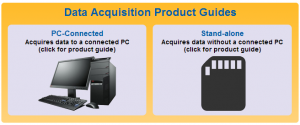If you need to digitize an analog signal, record it, and provide a method to analyze it, do you need a data logger or a data acquisition system? It has become increasing clear that the answer is ‘Yes’ to both products. What I mean is that the traditional definitions of these two broad product categories have become blurred to such an extent that they’ve become one-and-the-same.
Traditional Data Logger and Data Acquisition Definitions
I’m old enough to remember when data loggers were battery- or DC-powered devices that sampled very slowly (once per second was considered very fast.) They featured on-board memory to operate without a connected computer, and they may or may not have had a built-in display of some sort. Finally, they usually featured very high analog-to-digital conversion resolution.
In contrast, data acquisition referred to a system that operates while connected to a computer and uses the computer’s display and storage facilities. The typically lower analog-to-digital conversion resolution of data acquisition systems was compensated for with much higher sample rates on the order of 100 kHz or more.
In the traditional sense, data loggers were plodding instruments deployed in places and applications where others couldn’t go, and data acquisition systems were nimble thoroughbreds connected to a ball and chain in the form a computer.
Time Blurs Traditional Distinctions
If we fast forward, the above legacy definitions for data logger and data acquisition have all but vanished. Whether due to advancements in technology, evolution of the vernacular, or a combination of both, the two terms are increasingly and likely permanently used interchangeably. We talk to customers who say they want PC-connected data loggers, and those who want stand-alone data acquisition systems. The melding of the two terms is so complete that it’s futile to use them as starting points for a discussion of product solutions, since doing so injects confusion and is likely to start down the wrong product path. As a supplier of both kinds of products, we need to find a better, more efficient way to match customer requirements to product features.
Stand-alone versus PC-connected

New buttons on our website to select PC-connected or stand-alone products. Another captioned “Data Logger Product Guides” sends you to the same place.
If asking a customer whether she wants a data logger or data acquisition system is ambiguous, asking if she wants a stand-alone or PC-connected solution instantly defines the requirement and begins a meaningful discussion of product solutions. While customers do not differentiate between data loggers and data acquisition systems, all know if they want to use a PC to acquire data, or if they want the instrument to operate without a connected PC.
As such, DATAQ Instruments has split its product choices along these lines, the first manifestation of which are two filtered product selection guides, one for stand-alone products and the other for PC-connected. So, it no longer matters if you define data loggers and data acquisition systems along traditional lines, or if you’re a contemporary with different ideas on the matter. All you need to know to get started on the right product path is: Do you want one that acquires data to a connected PC, or operates without one?
We invite you to try our new product guides by following the links in the Additional Reading section. Place “Product Guide” in the subject and email us at sales@dataq.com with your comments. We’d love to learn your thoughts.
Additional Reading:
Stand-alone Data Logger and Data Acquisition product guide


 View Cart
View Cart sales@dataq.com
sales@dataq.com 330-668-1444
330-668-1444